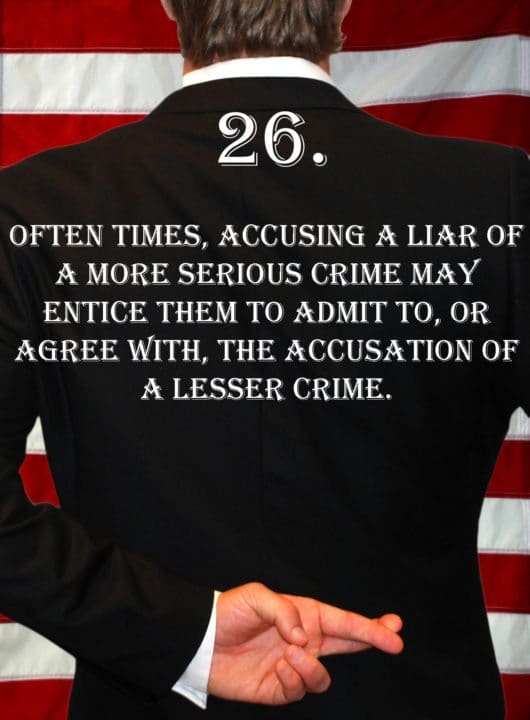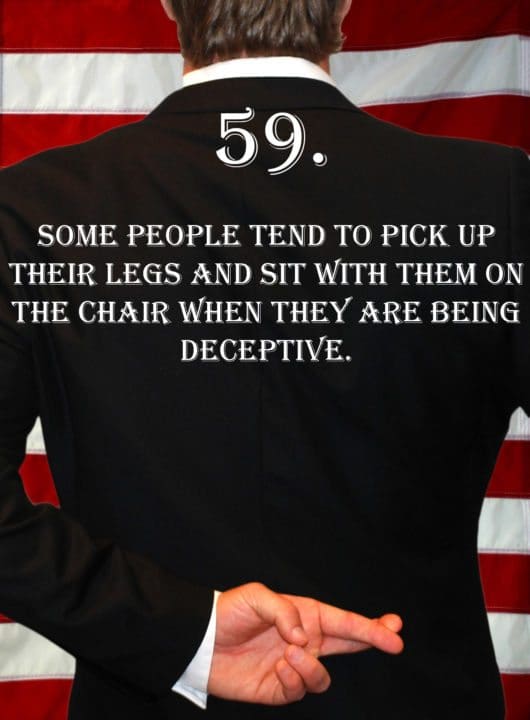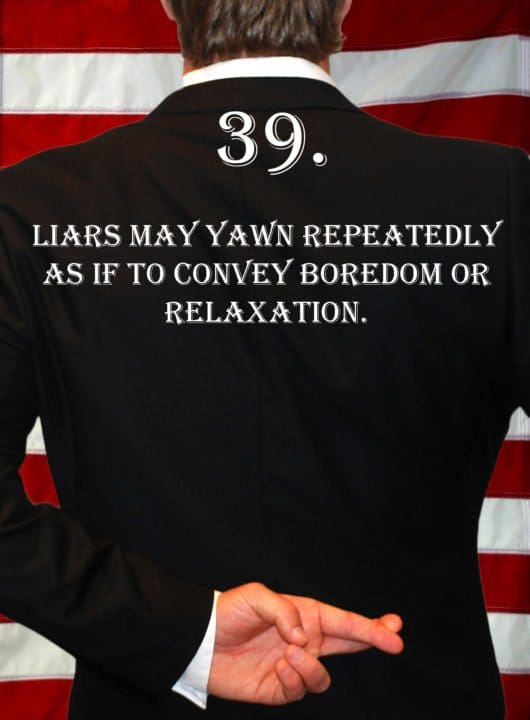
Deception Tip 26:
Often times, accusing a liar of a more serious crime may entice them to admit to, or agree with, the accusation of a lesser crime.
Listen To The Podcast!
E26 – Accusing Liars – Deception Tips Podcast – Click Here To Subscribe
Podcast Transcript
Hello and welcome to the deception tips podcast where you will learn amazing cues to detect deceit that will help you read people like never before. I’m your host of Spencer Coffman, let’s get started.
Welcome to episode 26 of the deception tips podcast. I really hope you’re getting into these podcasts and enjoying each and every episode and that you really are learning a lot. If that is the case, feel free to let me know.
I’ve got a Facebook page, facebook.com/bodylanguagefbpage, Spencer Coffman. You can search it on Facebook and you’ll see it’s also on the book page, but all the podcasts are posted there as well. Put some comments on there, let me know what you think.
Also, it would be cool if you’d review the podcast on iTunes or wherever you’re listening to it, and put your comments in there as well. Let me know what you guys are thinking of this podcast because we’ve got a hundred and one total episodes and we’ve got a long way to go and I want to make sure you’re enjoying them. If I need to change anything then I’ve got to change it sooner rather than later.
So, last time we spoke about something that we’ve kind of talked about on and off for quite a while now, it’s ‘yes’ or ‘no’ answers. So, we said that liars answer with ‘yes’ and ‘no’ questions, and if they can’t answer with ‘yes’ or ‘no’, then the target needs to be suspicious or the questioner needs to be a little bit suspicious.
We started this way back in episode 10 about quick answers when I said that a quick answer of ‘yes’ or ‘no’ followed by a delayed or waiting a little period and then an explanation comes, then that is also suspicious.
Now, this could take the form of two different varieties. Number one would be a quick answer of ‘yes’ or ‘no’ as in, “did you work out after work yesterday?” “Yep” or “nope” and then it could also take the, “did you work out after work yesterday?” “Yes”, then there’s like a but coming or “no” where they kind of drag it out.
And when they drag it out a little bit, then it’s like they’re implying that there is going to be an explanation. So, they say “yes”, and then you know that an explanation is coming.
So, if that happens, it’s a little bit more normal and a little bit more acceptable than if they just say ‘yes’ or ‘no’ right away and then pause, and then an explanation comes because then you know that they took a little break to think about what they’re going to say.
And now, by a little break or a little pause, we’re not talking like they say yes, and then five minutes later they start explaining. I’m talking like a fraction of a second, they may say something, and then maybe a second later or half a second later they start out with their explanation.
We also talked about this in converting statements like when we said converting positive statements to negative and negative to positive. That was in episode nine actually, and I hinted a little bit there on ‘yes’ and ‘no’ responses because I said well if you use implying questions that are not ‘yes’ or ‘no’, that’s kind of where we started out and said look the best questions to ask are ‘yes’ or ‘no’ questions.
Then in episode 10, I kind of followed up with the quick answers of ‘yes’ or ‘no’. And then last time we really dove into it and learned a lot more about the differences in the responses of ‘yes’ or ‘no’.
So, the longer it takes a liar to answer or the longer it takes anyone, I guess, to answer a ‘yes’ or ‘no’ question, the more suspicious the target should be. The reason is that the simplest and easiest question is a ‘yes’ or ‘no’ question. If I asked you, “did you go to work yesterday?”
You immediately “come on, did you go or not? Yes or no? It’s not an essay question”, that’s a line my uncle always used to say. It’s not an essay question, as in, hurry up, give me the answer, it’s a yes or no question, let’s go, it’s yes or no. Sure, a lot of people want to explain, but the answer is ‘yes’ or ‘no’.
It’s very, very simple. “Did you do this?” “Did you not do this?” “What happened?” ‘Yes’ or ‘no’. So, the longer it takes to answer a yes or no question the more suspicious the target should be.
Now, today we’ve got another deception tip and it’s one that kind of piggybacks on another one that we talked about a while ago. We talked about it in episode 21, and it was suggesting answers where a person, the questioner or the target, can suggest answers to the people who are giving the story or the liar. And sometimes they may agree with or incorporate those answers into their stories.
It’s also like where you can kind of give them certain stories like that example that I gave you about the people in Texas when I had said, “oh I’ve never been to Texas, have you?” and they said “no” boom, I caught them in their lie because of that.
Because I started to believe them or not really believe them, I started to give them a hint or show them a false reality that I was believing them. And then they got to open up a little bit more or I suggested different scenarios that they didn’t know whether or not they were real, and they just started running with it and using it in their lie. So, that’s how you can know that they’re lying.
So, this time today, we are going to continue on that, continue on the strategy side of things of suggesting answers or giving them things to work with. Today we’re going to talk about accusing them of more serious crimes.
So, for example, when I talked about suggesting answers and I mentioned that liars will often admit to certain things or you can use some things to leverage them to get them to fess up to other things, that’s what it is today.
If you accuse someone of a greater crime, chances are they’ll fess up to the less crime. So, maybe they stole something, and you charge them, you say this is going to be a felony.
Not only did you steal the piece of gum from the grocery store, but you happen to grab the baseball card and that was worth $500,000, that’s grand larceny, you’re looking at life in prison. And the person’s like “well, wait a minute, whoa, I just took a couple of pieces of gum” boom they fessed up.
So, that’s what it is today. Here it is, deception tip 26. Oftentimes, accusing a liar of a more serious crime may entice them to admit to or agree with the accusation of a lesser crime.
Here it is again, oftentimes, accusing a liar of a more serious crime may entice them to admit to or agree with the accusation of a lesser crime. So, what’s happening here? What are they doing? Well, we’re going to talk a lot more about it coming up right after this.
Join the thousands of deception tips blog followers on Tumblr. Share your thoughts on the podcast, the videos, and the books. Find it today on tumblr.com.
When you are trying to get something from someone, now this isn’t when you’re trying to manipulate them into giving you something. Now, this is a form of manipulation because you are giving them something to work with or you’re accusing them of something that perhaps you know they didn’t do. Remember that saying, it takes a thief to catch a thief or you have to fight fire with fire? In this circumstance, you’re using their own tactics against them.
So, you may know very well that they didn’t do the more serious thing. Like, let’s say you have someone who is the last person to see someone alive and you’re going to pin the murder on them.
And so, the question is whether or not they were there, and they said they weren’t, and you say, “well, we put you there, we have you on murder.” And they say, “no wait a minute, I just went there to do, whatever. I went there to steal something, or I went there to do a lesser crime, but I didn’t murder anybody”, that is using a tactic.
You are essentially lying to them by telling them we have this on you, we are going to pin this on you, you did this and they’re going to say, no, no, I didn’t do that I only did this, I didn’t take it that far. I just roughed him up a little bit and I left him very well. He was alive when we left him. And then now you have them fessing up to beating the guy up or something.
Now, these examples that I’ve given you, yeah, they all have to do with crimes or law enforcement or anything. And you may be wondering like, well, wait a minute, I’m not a cop or I’m not a detective or an interrogator, so how can I use this? Well, you can use it in your everyday life.
This is something that you can use with your kids. “Hey, did you take the trash out?” “I did, yeah, I took the trash out.” “Okay well, you broke the garbage can.” “Oh, I’m sorry. No, I didn’t, I didn’t take the trash out.” It’s kind of a different scenario in that and we talked about this before where you caught them in their lie by accusing them of something else that was greater than the consequences of their lie. Or, you could do things like using it in your job with sales or working with other employees.
When you get people to do greater things, they often do lesser things. So, if you’re saying, “well, I’m going to give you XYZ job responsibilities” or “we’re going to sell you this at XYZ price”, they may say, “no, wait a minute now, that’s too much” or “that’s not right”, then they’ll come down and use the other one.
For example, let’s say you’re going to go buy a new rug. You go look at the rug and you say, “you know what, I’ll give you a thousand bucks the person says, “wait a minute, a thousand bucks? I wouldn’t sell it for less than 1600”, and it’s a $4,000 rug, boom you just got it for 1,600. Why? Because that person fessed up to your lowball offer and that kind of worked out that way.
So, it is a sort of manipulation tactic. However, it depends on you how you are going to use it. You can use it in many different ways. You can use it in many different scenarios. You can twist it, you can do whatever you like with it. But it’s up to you whether or not you are going to use it for seeking the truth or for finding and furthering deception.
And that is true with any of these tips. I tell you a tip on how to read people and how to catch a liar and if you turn around and use that the other way as in, well, make sure to watch out for people who fold their arms or who cross their legs a certain way.
And you say, okay, well now when I lie, I know not to do that, that’s entirely up to you. Whether or not you want to take this information and use it for a benefit or use it for harm is up to you. I’m telling you though, that if you use it for a benefit, it will be a lot better for everyone else.
So, accusing liars, why does this work? It works because it’s a fear tactic. When someone is accused of something greater, when they start to see the walls close in on them a little bit and they start to realize that “hey, wait a minute, I got caught.
This is no longer me lying to try to get away. Now, it’s about how can I preserve what I have left? So, a real huge switch happens here. It’s like a completely different form of interrogation and questioning, not only for the interrogator or the target but also for the liar.
So, initially, when a liar is telling lies, his or her primary goal is to get away with that lie, is to make sure that other people believe what he or she is saying, they want to be believed, it’s about fooling someone else.
So, there’s tension inside their body, which we’ve talked about many times and this is why all of the leakages occur. The conscious and the unconscious are fighting against each other, which creates tension and leakage happens as a result of that.
Then, as the target shows different signs of belief or shows that they may be being fooled, the liar will continue to leak signs such as arrogance or contempt or something like that, etc. And they will start to believe that the target is believing their lie.
At that point, they kind of ease up a little bit, and now they can get caught or trapped in their lie because they think that they have already won. And in essence, the target is just making them believe that, so the target is using that against them. It’s like a judo move, it’s using their own force against them.
Then when the liar starts to realize that the target is not believing them, now the tension comes back and it’s even greater because they said, “well wait a minute, I was tense, I was telling a lie, I was happy for a minute because they believe me and now, I realize that they just hustled me.
They pulled one over on me and man I am in big trouble because they just caught me, and I can’t lie my way back out of this. So, they start to realize that.
At this point, the interrogator or the questioner, whatever you choose to call them, can start using these more advanced interrogation techniques or advanced lie detection techniques and start using these tactics against them.
They can start suggesting answers or accusing them of greater crimes to get them to fess up to the other stuff that they already lied about in that they were already caught in.
Usually, an interrogator is not going to accuse them of something to get him to fess up to something else unless they’re pretty certain that they did the other thing. So, that is already been determined through the other interrogation. They have already really caught them in their lie.
They know that they’re lying and now it’s just about showing them that they were stupid about lying and giving them these other alternatives to kind of own up to it so that they feel a little bit better. And then that eases the tension and now they say, “look, you’ve already caught yourself in a lie, now you just confessed.
Let’s move on, let’s continue, let’s get you to sign some paperwork or let’s get you to do whatever is next, and let’s start the process down so we can wrap this up and get it behind us.” And then usually they start to cooperate very, very much. And it’s a lot better of a scenario if that can happen.
So, there’s a real progression in the mind of a liar when they’re going. It’s all just a big battle. They’re tense, then they may ease up then when they get caught again, now it’s like they explode inside. And then when they fess up, there’s like a relief like finally, I guess I just told the truth.
And then the interrogator can push a little bit more and then they’re going to feel better about letting it all go out, they told the truth. However, now they have to deal with the consequences of that lie, so then there will be tension again. So, it’s going to be a never-ending cycle for a long time for that person who’s a liar. So, that is why it is very important, to tell the truth, if at all possible.
Obviously, you don’t want to be a blunt instrument and just tell the truth all the time. “Boy that haircut looks stupid on you”, or whatever. “Ah, man, you shouldn’t have worn that shirt today” or something like that.
That’s very insensitive and jerkish, so you don’t want to do that. You got to still be polite, but when it matters, tell the truth. And keep an eye out for other people who are not telling the truth.
So, I want to thank you for listening to the deception tips podcast today. I want you to share it with your friends, subscribe to the feed, check out the deception tips blog, and take a look at the books I have available. And as always, tune in next week for a new deception tip.
Video Transcript
Hey guys, my name is Spencer Coffman, thank you for watching the deception tips videos. They’re all about teaching you how to read people and detect deception so that you will be able to tell if someone is lying to you.
Today, we are going to talk about a cool tactic that you can use to determine whether or not someone is telling a lie. What you can do is suggest things to them, you can give them different ideas or different things that maybe they might want to use or that they might get afraid of in order to get them to reveal the truth or to admit to something.
So, this is deception tip number 26, often times, accusing a liar of a more serious crime may entice them to admit to or agree with the accusation of a lesser crime. So, this is a good strategy that you can use when you’re trying to figure out if somebody did something or if somebody didn’t do something. Typically, it would be if someone did something because if you use this when they didn’t do something, it takes more of a place of a threat.
If you’re talking to your kids and they say, well, I can’t find my shoes and you say, okay, well if I find them then you’re going to get in trouble because you know that they didn’t look very hard. Then they go back, and they find them, that’s more like a threat because they didn’t do something. However, if they did do something and you’re trying to find out whether they did it, like did you leave the water on or did you leave the light on and they say no, well then you could start suggesting something like this with a more serious consequence.
Well, you left the light on and now the bulb burnt out, so you need to pay $1 out of your allowance. For a little kid that could be something serious and they might say, okay I know I left the light on, but it’s not burnt out yet and you kind of suggested something. So, you’re incorporating a little bit of deception as well by suggesting a higher consequence or something with a higher consequence to get them to admit to or agree with the charges brought against them on a lesser crime.
So, now this could really work in law enforcement situations where maybe someone broke into a house and they were the last person to see someone alive. You probably see this on TV all the time where they may accuse him, they say, well, we have your prints at the scene or we know you were there we have a witness that saw you there and we’re going to pin the murder on you. And the person is like, now wait a minute, okay fine, I was there but I just stopped by for a little bit and they were alive when I left him.
Two minutes ago, they were saying no they weren’t there. Well, now they’re agreeing with the lesser crime because they don’t want to get murder pinned on them. They’ll admit to or agree with the lesser crime to avoid something of a greater crime. The people interrogating him may know very well that they didn’t murder him, they may say, this guy doesn’t have the brains to do it or this person wasn’t there, or they have some other evidence that indicates it in a different direction. But they’re using that tactic to get that person to admit to being there so at least they have a timeline that’s narrowed down.
So, this works very well not only in law enforcement situations but also in situations as I’ve said before with children and with other people as well. You can suggest different outcomes, different consequences, different things that are more significant or have more or greater consequence than what they are trying to figure out at a first level. Oftentimes, the liar will get scared and they will admit to or agree with what you are first suggesting.
So, really what happens is they’re telling a lie then you’re getting them to admit to something. So, first they’re saying no, it wasn’t me, I didn’t do it, nothing happened then you’re saying yes, it was you. Then you say, fine, okay, maybe it wasn’t but maybe you did this as well, so the third level. And they say, no, no wait a minute, I’ll change my lie I’ll agree with what you’re accusing me of, but I didn’t do this.
So, now they’re contradicting their first story, thus proving that they were a liar and they’re agreeing to what you said in the first place but because the stakes have changed and now the threat is greater, they are agreeing with something lesser. In addition to this strategy, you can use other strategies that we’ve talked about in other videos and you can also look for signs of deception on their body and face and in their speech as well because there will always be more than one sign.
So, if this is your first time watching the videos, I would love to have you subscribe to the channel on YouTube. Feel free to leave any comments or questions there as well. Also, we have all kinds of information available for you, books, blog posts, podcasts, etc. all on spencercofffman.com that are dedicated to teaching you exactly what everybody is saying.
Until next time.






